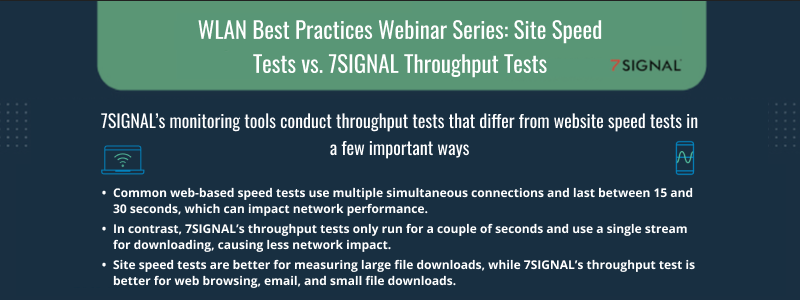
Blog
WLAN Best Practices Webinar Series: Site Speed Tests vs. 7SIGNAL Throughput Tests
7SIGNAL’s monitoring tools conduct throughput tests that differ from website speed tests in a few important ways

Many network engineers and company employees turn to online speed tests to analyze how fast their devices and the network can send and receive data.
These web-based speed tests are usually pretty effective for testing large file downloads, but they can strain a network and don’t work the best for web browsing and email testing. 7SIGNAL provides consistent throughput tests along with our monitoring platform that assess these other speed applications more effectively while causing less impact on a network.
Here’s a detailed comparison of standard site speed tests with 7SIGNAL’s throughput tests:
How do web-based speed tests work?
First, let’s explain how site speed tests work by examining two of the most common: speedtest.net and fast.com.
1. Speedtest.net by Ookla
Speedtest.net uses up to four simultaneous connections during a download. It then adds all the values across multiple connections to get a speed number.
These tests run for about 15 seconds, which is fairly long. The test also varies the buffer size and how much data it sends to maximize throughput. The goal is to essentially flood the internet connection with data to look at the full capability of the device and the network.
2. Fast.com by Netflix
Fast.com employs up to eight simultaneous connections during a download, and it uses the huge Netflix CDN to host speed tests. Those servers are hosted very locally all over the world, so they can provide a lot of bandwidth to many customers. These tests run up to 30 seconds.
Fast.com results reports ignore the first part of the test that usually runs a little slower to try and report the fastest speed.
Pros and cons of web-based speed tests
To summarize how these tests work: speed tests run multiple simultaneous connections, do long test runs, and try to max out or flood the connection. They thus simulate large file downloads very well but assess web browsing and email use pretty poorly.
These tests can also significantly impact the network when they are running — their longer duration can strain the network a bit if multiple users conduct tests simultaneously. People in an office may want to compare their numbers, for instance. But if they all run tests at the same time — and try again and again — they may slow performance and get lower numbers that aren't entirely accurate.
In addition, the servers these tests rely on are often hosted in the central offices of major internet service providers (ISPs). So, sometimes you’re just measuring the performance from your device to the ISP and their data center.
Another note is that these sites make a point to say they’re doing speed tests the “right” way to measure throughput, claiming that no other method of doing this is as accurate. But this isn’t exactly the case.
However, web-based speed tests can be very useful for a point-in-time measurement or a read on the absolute maximum network capability when using internet-based services.
7SIGNAL’s throughput test
The 7SIGNAL throughput test approaches things differently. We only use a single stream for downloading, and the test only runs for two seconds.
Our test simulates web browsing (where you’re fetching lots of small files like jpegs and text), email, and small file downloads very well. However, the test doesn’t simulate large file downloads as effectively as the online site speed tests.
The ultimate benefit of our test is to make consistent measurements again and again without much of an impact on the network being assessed, whether those evaluations inform our Sapphire Eye® or Mobile Eye® monitoring solutions. And it isn’t just one person running a speed test—several devices run it every few minutes or so.
The 7SIGNAL throughput test is excellent for measuring what most internet traffic looks like while having a pretty light impact on the network as it runs. 7SIGNAL can run a longer test time if desired, but we like two seconds for minimal network impact.
How does TCP slow start work?
So, why does test length matter for different types of tests? The transmission control protocol (TCP) has an impact on the results.
The TCP slow start test is part of TCP’s congestion control. The idea is that if you’re missing acknowledgments (ACKs), you reduce the number of bytes or packets allowed in flight. Slow start begins ‘pessimistic,’ meaning it only sends a small number of packets (like one to four). Then it waits for those ACKs to come back before sending more.
As the ACKs come back, the test allows more and more packets in flight. It continues cranking that number until it reaches the maximum window size set on the server or when it starts missing ACKs or experiencing delayed ACKs. In these cases, the TCP slow start test closes that window down and reduces the number of packets it’s allowing, followed by gradually letting them ramp up again.
The slow start test accurately shows how your device or computer knows how much data it can send or how much throughput it can consume. It assesses how fast the client can go with that connection.
TCP does not use anywhere near the full network bandwidth end to end because of latency sensitivity. And new research and proposed algorithms are set to improve TCP to meet the conditions typical for today’s networks.
7SIGNAL’s throughput tests are just one example of consistent, valuable metrics
7SIGNAL’s wireless experience monitoring tools deliver consistent insights into how a network performs, and speed is just one of over 600 KPIs tracked by the platform. Mobile Eye® and Sapphire Eye® allow network managers to assess Wi-Fi performance in real-time from the end-user’s perspective, enabling fast solutions to any problems.
Learn more about our testing and wireless network monitoring solutions by contacting 7SIGNAL today.
7SIGNAL® is the leader in wireless experience monitoring, providing insight into wireless networks and control over Wi-Fi performance so businesses and organizations can thrive. Our cloud-based wireless network monitoring platform continually tests and measures Wi-Fi performance at the edges of the network, enabling fast solutions to digital experience issues and stronger connections for mission-critical users, devices, and applications. Learn more at www.7signal.com.